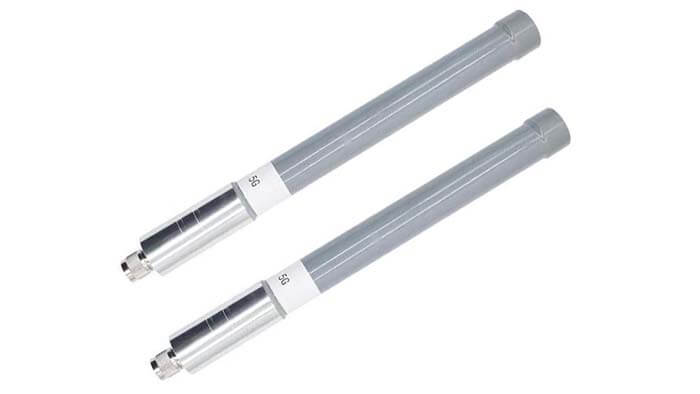What are the antenna application scenarios for each frequency band of RF 400MHz~6GHz antenna band?
Antenna applications at different frequencies
Lora antenna applications
The most widespread frequency bands are between 400 MHz and 6GHz, and they have different names according to the application scenarios in the band division. Low frequency ranges from 400MHz to 433 MHz and 868 MHz to 960 MHz, which belong to long-distance data stable transmission antenna application scenarios.
For example, we often hear and see the intercom, wireless meter reading, monitoring, and other products that use low-frequency narrow-band communication technology. 868MHz 915MHz 930MHz also belong to the antenna named Lora.
Lora antenna applications are smart cities, smart parking, smart meter reading, smart agriculture, smart farm, and other industries.
NB-IoT antenna applications
NB-IoT refers to Narrow Band Internet of Things (NarrowBand-IoT) technology, which focuses on the Low Power Wide Area (LPWA) Internet of Things (IoT) market and is an emerging technology that can be widely used worldwide. NB-IoT uses a License band and can be deployed in three ways to coexist with existing networks.
NB-IoT is an emerging IoT technology that has attracted much attention because of its low power consumption, stable connection, low cost, and excellent architecture optimization.
How are the frequency bands for NB-IoT divided by domestic and international operators?
Most operators worldwide use the 900MHz band to deploy NB-IoT, and some deploy it in the 800MHz band.
China Unicom’s NB-IoT is deployed in the 900MHz and 1800MHz bands, and currently, only 900MHz is available for trials.
China Mobile will get an FDD license in order to build NB-IoT IoT and will be allowed to re-farm the existing 900MHz and 1800MHz bands.
China Telecom’s NB-IoT is deployed in the 800MHz band with only a 5MHz frequency.
NB-IoT antennas should be used in smart meter reading, smart car locks, and other industries.
GPS antenna applications
1575.42MHz, 1227.60 MHz GPS, 1561 MHz, and 1207 MHz BeiDou belong to satellite search and positioning; GPS/GNSS antenna application is GPS positioning service.
GSM/Wifi antenna applications
4G LTE antenna applications
4G bands include 698-960 MHz, 1710-2700 MHz with the full-band 4G LTE for LTE, NB-IoT, Lora, 2G, 3G, 4G, GSM, GPRS antenna applications.
5G NR antenna applications
5G NR bands include 3.5GHz (in principle for indoor use), 3400-3600 MHz, and 4800-5000 MHz.
New 5G antenna applications are the industrial field, telematics, autonomous driving, energy field, education field, medical field, smart city field, financial field, information consumption field, etc.
Those involving 2G/3G/4G/5G mobile communication bands belong to low latency and ultra-low latency network communication, capable of transmitting and sending massive data packets, files, videos, and pictures.
The 400MHz – 6GHz frequency band antenna application scenarios are used for cell phones, smart homes, smart industries, smart cities, and other devices respectively.
How to choose the right RF antenna?
Microwave omnidirectional antenna is more used in one-point multi-address communication, commonly used in military, aerospace, remote control, and telemetry range.
In the more broadcast segment, microwave omnidirectional antenna, interpolation feed type antenna, and waveguide slot antenna.
And with the novel communication principal flourishing, communication frequency to higher band flourishing has been a certain tendency, in the C band or higher band, the range is very short, above-mentioned antenna because of structure adulteration, guide processing cost high, adjustment and test arduous, and feed structure is also difficult to arrange, make the antenna bandwidth narrower.
In the omnidirectional antenna, Fiberglass antenna performance is the best, its core is the pure copper oscillator, using the balanced feed, less affected by the environment.
The shell is made of high-quality glass fiber reinforced plastic, with good tri-proof characteristics and good adaptability to the harsh natural environment.
It is especially suitable for ultra-long distance gateway, signal coverage, image transmission, etc. It is generally used in environments with long communication distances, small-signal coverage, and high target density.
The most extreme example is point-to-point remote communication. The utility model is highly efficient, light in size, easy to install, and can take into account both gain and radiation area.
It is suitable for indoor and tunnel wireless signal coverage; medium-distance signal transmission, image transmission, and through-wall signals.
The gain is very high, slightly larger in size and directional.
Attention should be paid to the direction of the antenna when using the antenna. It can be used for ultra-long distance signal transmission, image transmission, direction finding, etc. Ultra-wideband antenna has very wide bandwidth coverage, bandwidth up to 10:1, commonly used for signal amplification, indoor wiring, and elevator signal coverage.
A small antenna mainly has a built-in antenna and an external antenna two kinds, built-in antenna is objectively inevitably weaker than an external antenna. The antenna is set up as far away from the ground and the building, the antenna is close to the reference, so most of the energy will be concentrated in the antenna and the reference between, and cannot smoothly launch, so the antenna launch, need an as open as possible space.
The small internal antenna type includes the chip antenna, spring antenna, PCB antenna, flexible PCB antenna, etc. The small external antenna type includes a rubber duck antenna, magnetic mount antenna, through-hole mount screw cabinet antenna, etc.
The small antenna applications are for indoor & outdoor wireless communications, you can easily find the different antenna types on our website.
Besides the What is Each RF 400MHz~6GHz Antenna Application article, You may also be interested in the below articles.
Internal Antenna VS. External Antenna
LTE Vs. 5G: Is 5G Better Than LTE?




